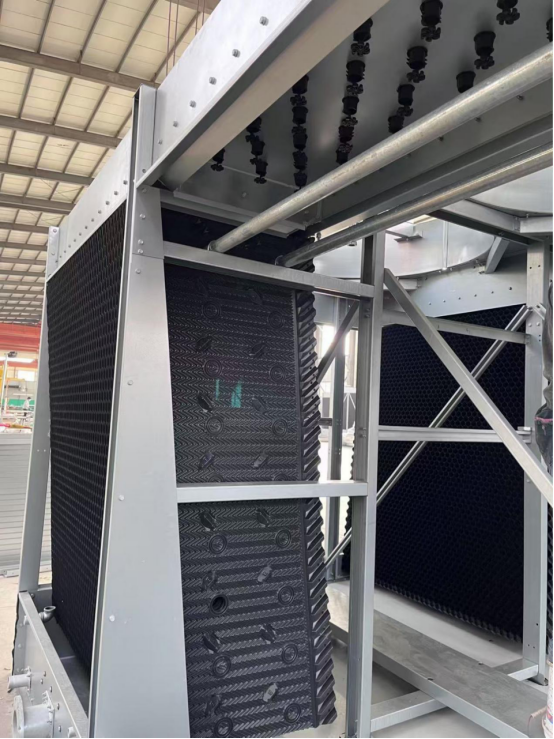Spray nozzles are essential components in cooling towers, playing a direct role in water distribution and overall thermal performance. Their function affects the system’s heat transfer rate, energy efficiency, water consumption, and operational stability. When spray nozzles are properly selected and installed, they contribute to more reliable and cost-effective cooling operations.
In cooling towers, spray nozzles disperse circulating hot water over the fill media in the form of fine droplets or consistent spray patterns. This enhances water-air contact, accelerates evaporation, and improves heat removal.
Evaporative cooling can account for up to 85% of the total heat rejection
Uneven or incomplete water coverage can reduce cooling performance by 15–20%
Ideal droplet sizes are typically between 2–5 mm, balancing effective evaporation with low drift loss
Operating pressure for counterflow cooling tower nozzles generally ranges from 0.5–2.5 bar
Type | Spray Pattern | Droplet Size | Flow Rate Range | Typical Use |
Full Cone | Uniform circular | 2–5 mm | 10–50 L/min | Power stations, HVAC |
Hollow Cone | Circular ring | <2 mm | 10–60 L/min | Petrochemical plants |
Flat Fan | Narrow band | 1–3 mm | 5–40 L/min | Compact cooling units |
Square Spray | Overlapping grid | 3–4 mm | 15–55 L/min | High coverage applications |
Air Atomizing | Mist/fine fog | <0.5 mm | <5 L/min | Precision cooling systems |
In performance comparisons, square spray nozzles have shown to improve fill coverage by up to 25% compared to traditional circular nozzles, helping eliminate dry zones and uneven thermal loading.
Material | Max Temperature | Chemical Resistance | Estimated Lifespan |
Polypropylene | 85 °C | Good | 3–5 years |
PVC / ABS | 65–75 °C | Moderate | 2–4 years |
Nylon | 100 °C | Excellent | 5–8 years |
Stainless Steel | 250 °C | Excellent | 8–10+ years |
For systems exposed to high scaling or chemical exposure, nozzles made from nylon or stainless steel provide longer operational life and reduced maintenance frequency. In heavy-duty installations, stainless steel nozzles can remain operational for over a decade with minimal performance loss.
Spray nozzles provide multiple operational advantages throughout the cooling tower process, contributing to better system performance and long-term reliability.
Consistent Water Distribution: Uniform spray ensures that all fill surfaces are utilized effectively, preventing hotspots and maintaining optimal airflow paths.
Improved Heat Transfer Efficiency: Fine water droplets increase the surface area for evaporation, reducing outlet water temperature more effectively.
Reduced Fan and Pump Workload: With better water distribution, the system requires less airflow or pumping power to achieve the same cooling capacity, which lowers energy consumption.
Fewer Maintenance Interruptions: Anti-clog nozzle designs reduce scaling and debris accumulation, minimizing cleaning frequency and operational downtime.
Protection of Fill Media: Even and gentle water spraying prevents structural damage to fill media caused by uneven or high-pressure flows.
Lower Water Loss and Drift: Controlled droplet size and spray angle minimize the loss of water as mist or drift, which improves water usage efficiency.
These advantages directly impact productivity by enhancing thermal stability and reducing system interruptions, making spray nozzles a key component in reliable cooling operations.
Selecting the right spray nozzle depends on various engineering and operational factors. Here’s a practical guide to help in the decision-making process:
Full Cone: For complete circular coverage
Square Pattern: For grid layouts and precise coverage
Flat Fan: For narrow fill areas or directed spray
Match nozzle specifications to system pressure (e.g., 0.5–2.5 bar)
Choose a nozzle that delivers the required L/min without overloading pumps
Smaller droplets offer faster evaporation but are more prone to drift
Choose 2–5 mm for balance between cooling performance and drift loss
High-temperature or chemically aggressive environments require durable materials like nylon or stainless steel
For standard HVAC or light industrial use, PP or ABS may be sufficient
Look for nozzles with tool-free access, clip-on designs, or self-cleaning features
Consider ease of replacement and availability of spare parts
For film fills, use full cone or fine spray nozzles to ensure maximum surface coverage
For splash fills, larger droplet nozzles may be more appropriate
By carefully evaluating these factors, engineers can ensure that the selected spray nozzles support efficient cooling, reduced operational costs, and longer equipment life.
Spray nozzles may be small components, but their influence on the performance of cooling towers is significant. From improving water distribution to lowering energy usage and system wear, well-designed spray nozzles contribute directly to operational efficiency and cost savings. For any cooling system upgrade or new installation, selecting the right spray nozzle type, material, and spray pattern is a smart and necessary decision.
